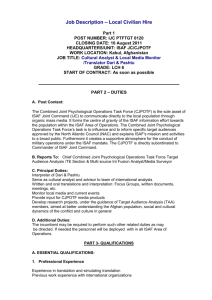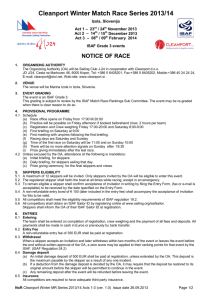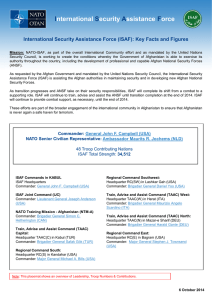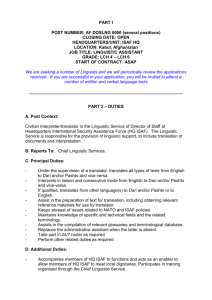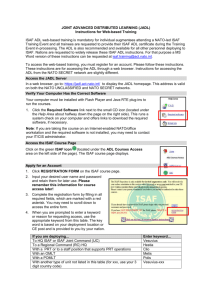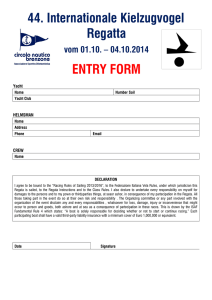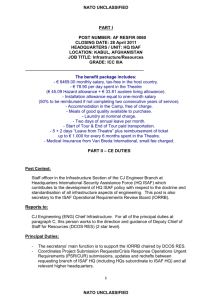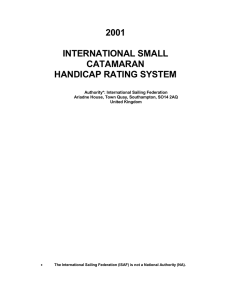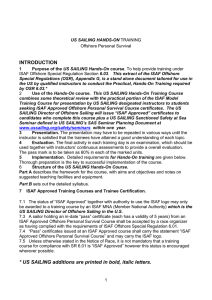2016 Welcome to ISAF (World Sailing) ISAF Safety at Sea
advertisement
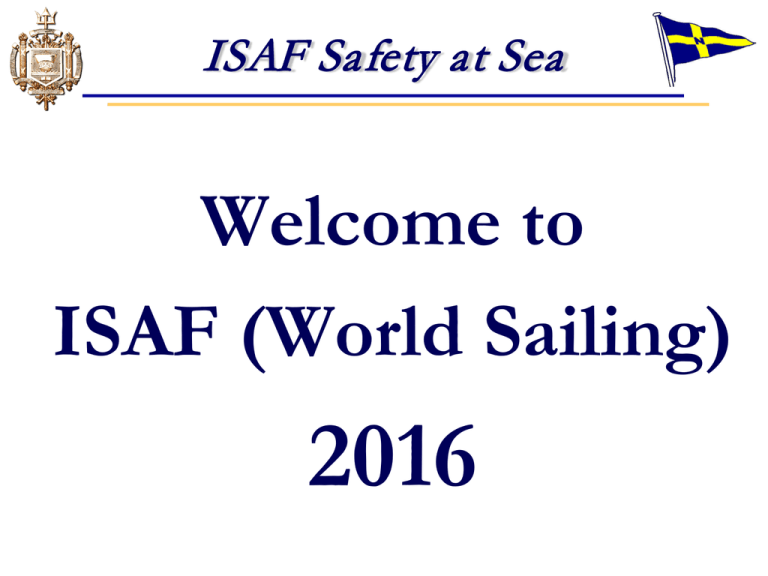
ISAF Safety at Sea Welcome to ISAF (World Sailing) 2016 2016 Safety at Sea Time 0830 GROUP color Location Luce Planetarium Opening Remarks Red Stars B/W Checks Blue Yellow Pool Fire Safety Comms Macdonough 0900-1030 0900-1015 0900-1015 0900-1015 Dan O'Connor Comms Pool Fire Safety Fire 1045-1200 1030-1200 1015-1130 1015-1130 Luce Rm 003 Lunch Lunch Lunch Lunch Ned Ross 1200-1230 1200-1230 1130-1200 1130-1200 Pool Safety Safety Comms Pool Fire Luce Room 004 1230-1345 1230-1345 1200-1330 1200-1315 Henry Marx Fire Safety Comms Pool Comms 1345-1500 1345-1500 1345-1500 1330-1500 Luce Planetarium Kip Louttit 1515 Test Test Test Test Luce Planetarium ISAF Safety at Sea Ethos ? The distinguishing character, sentiment, moral nature, or guiding beliefs of a person, group, or institution ISAF Safety at Sea “Sailing Safety Ethos” Three legged Stool Safety Training and Practice ORM Situational Awareness ISAF Safety at Sea Safety Training and Practice Safety is the responsibility of everyone on the boat. • It starts with the Skipper and extends down to the “Nipper” or least experienced crew on the boat. • Designate a Second in charge, in case something happens to your Skipper, who can take charge and make decisions. ISAF Safety at Sea • USNA trains with people that are almost all new to sailing. They are encouraged to speak up if they see, hear, smell or feel anything is out of place. • If you’re new to a boat/crew, ask for a safety brief and find out where all the safety equipment is, and how to use it. Volunteer to be the safety officer and post a location chart and help train new people. • Train new crew how to make an emergency call on the VHF radio, especially if you’re short-handed. ISAF Safety at Sea • Practice MOB drills, have an abandon ship and fire plan, and discuss flooding mitigation, so you know what to do in an emergency. • If you’re going offshore, know your crew’s physical capability – and limitations, so you know what to do in a medical emergency ISAF Safety at Sea ORM Military has Operational Risk Management matrixes to determine risk levels for activities. There are four principles: 1. Accept Risk when Benefits Outweigh the Costs 2. Accept No Unnecessary Risk 3. Anticipate and Manage Risk by Planning 4. Make Risk Decisions at the Appropriate Level There are different levels of risk management, throughout the planning process In Depth ORM = Time is not a factor like today’s event ISAF Safety at Sea There are different levels of risk management, throughout the planning process In Depth Risk Management • Time is not a factor • SAS Seminar ISAF Safety at Sea Deliberate Risk Management • Analyze potential risks during planning stages • Figure out how to mitigate before you get underway, weather, crew experience etc. -Make sure all thru hulls can open and close, inspect all your safety equipment, are flares current, is anything broken/rusted, does the strobe light on your Lifesling work or do you need to replace batteries? -Check the weather forecast and consider postponing if adverse weather ISAF Safety at Sea Time Critical Risk Management Once you’re underway, you need to manage any emergencies as they come up. • Rely on training and factors you put in place during deliberate phase • Figure out what the priorities are: Steve D’Antonio talks about the boat flooding and fire breaks out – which do you address first? − Man overboard, Squall approaching, Broken mast on a lee shore, etc. ISAF Safety at Sea Situational Awareness • North U says “keep your head out of the boat”. You do that by knowing your boat and equipment thereby able to do evolutions with your eyes out of the boat increasing your SA Bubble • Novice sailors have a very small SA Bubble • Again, back to the sensory mode, why do I all of a sudden have a large quarter wave, or why does that tug I’m sailing behind have a yellow and white stern light??
